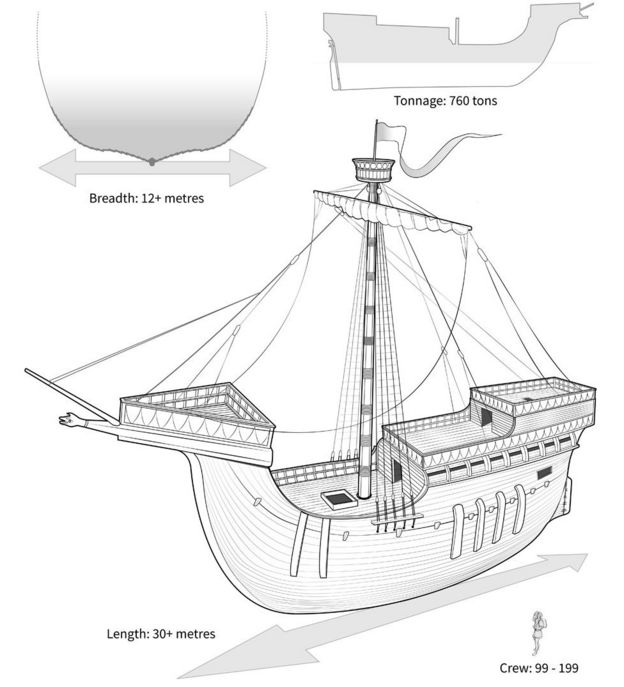The wreck of a 600-year-old warship which helped Henry V wage war on France is believed to have been found buried in a river on the South Coast.
The Holigost - or Holy Ghost - was one of four "great ships" commissioned by the king in his war against France.
It was spotted in an aerial photograph by historian Dr Ian Friel in an area of Hampshire's River Hamble described as a medieval breaker's yard.
Historic England said it was a "tangible link" to Henry V.
Henry V warship Holigost 'may be buried in River Hamble'
BBC News
12 October 2015

The carrack which had a crew of 200 sailors and carried large numbers of soldiers to war
The wreck of a 600-year-old warship which helped Henry V wage war on France is believed to have been found buried in a river on the South Coast.
The Holigost - or Holy Ghost - was one of four "great ships" commissioned by the king in his war against France.
It was spotted in an aerial photograph by historian Dr Ian Friel in an area of Hampshire's River Hamble described as a medieval breaker's yard.
Historic England said it was a "tangible link" to Henry V.
The Holigost fought in sea battles during the Hundred Years War which broke the French naval power.
Dr Friel identified the wreck when he was revisiting documentary evidence for a book on Henry's navy.

The ship is thought to be buried in mud on the River Hamble in Hampshire, in an area described as a medieval breaker's yard

Future scientific research on the ship, which could include sonar and aerial imaging using drones, could reveal much about 15th Century shipbuilding and improve understanding of life aboard ship, naval warfare of the time, dock building and docking practices.
Historic England said it was taking steps to protect and investigate the shipwreck in part of the river next to where Henry's flagship, the Grace Dieu, was identified in the 1930s.

Holigost
A major part of Henry V's war machine as he sought to conquer France
Had a crew of 200 sailors and carried large numbers of soldiers to war
The second of four "great" ships built for the king's royal fleet
Underwater repair work on the ship carried out by a "dyver" called Davy Owen in 1423 may be the first-recorded example of a diver used in ship repair in England
Duncan Wilson, Historic England's chief executive, said the investigation in the 600th anniversary year of the Battle of Agincourt was "immensely exciting."
"It holds the possibility of fascinating revelations in the months and years to come," he added.
Dr Friel said: "In my opinion, further research leading to the rediscovery of the Holigost would be even more important than the identification of the Grace Dieu in the 1930s.
"The Holigost fought in two of the most significant naval battles of the Hundred Years War, battles that opened the way for the English conquest of northern France."

Sketches show what the vessel would have looked like and its dimensions
Henry V warship Holigost 'may be buried in River Hamble' - BBC News
The Holigost - or Holy Ghost - was one of four "great ships" commissioned by the king in his war against France.
It was spotted in an aerial photograph by historian Dr Ian Friel in an area of Hampshire's River Hamble described as a medieval breaker's yard.
Historic England said it was a "tangible link" to Henry V.
Henry V warship Holigost 'may be buried in River Hamble'
BBC News
12 October 2015

The carrack which had a crew of 200 sailors and carried large numbers of soldiers to war
The wreck of a 600-year-old warship which helped Henry V wage war on France is believed to have been found buried in a river on the South Coast.
The Holigost - or Holy Ghost - was one of four "great ships" commissioned by the king in his war against France.
It was spotted in an aerial photograph by historian Dr Ian Friel in an area of Hampshire's River Hamble described as a medieval breaker's yard.
Historic England said it was a "tangible link" to Henry V.
The Holigost fought in sea battles during the Hundred Years War which broke the French naval power.
Dr Friel identified the wreck when he was revisiting documentary evidence for a book on Henry's navy.

The ship is thought to be buried in mud on the River Hamble in Hampshire, in an area described as a medieval breaker's yard

Future scientific research on the ship, which could include sonar and aerial imaging using drones, could reveal much about 15th Century shipbuilding and improve understanding of life aboard ship, naval warfare of the time, dock building and docking practices.
Historic England said it was taking steps to protect and investigate the shipwreck in part of the river next to where Henry's flagship, the Grace Dieu, was identified in the 1930s.

Holigost
A major part of Henry V's war machine as he sought to conquer France
Had a crew of 200 sailors and carried large numbers of soldiers to war
The second of four "great" ships built for the king's royal fleet
Underwater repair work on the ship carried out by a "dyver" called Davy Owen in 1423 may be the first-recorded example of a diver used in ship repair in England
Duncan Wilson, Historic England's chief executive, said the investigation in the 600th anniversary year of the Battle of Agincourt was "immensely exciting."
"It holds the possibility of fascinating revelations in the months and years to come," he added.
Dr Friel said: "In my opinion, further research leading to the rediscovery of the Holigost would be even more important than the identification of the Grace Dieu in the 1930s.
"The Holigost fought in two of the most significant naval battles of the Hundred Years War, battles that opened the way for the English conquest of northern France."

Sketches show what the vessel would have looked like and its dimensions
Henry V warship Holigost 'may be buried in River Hamble' - BBC News
Last edited:




